|
By Daniel Jessup - 13 Years Ago
|
I posted a while back asking questions about vibratory tumblers, who uses them, how do they work, results, yada, yada, yada. Most of the posts I read were neutral to negative, so I kept thinking how I could best clean all of those boxes and boxes (one is a banana box, lol) of Y block hardware. Some of the hardware has the usually buildup of surface rust, and still most of the nuts, bolts, washers, and do-dads have a load of grease/grime... especially in the threads.
Two weeks ago I pulled the trigger on an Ultrasonic Cleaner at china freight after a couple of guys I knew swore by the results when I asked about it. The price was pretty good when it was on sale and a 20% off coupon. Check out the before and after photos. The unit has a "heat" function, and then it has a few increments you could select from. To be frank, I was amazed at what it did. I've never seen something like this (that had no caustic solution or wasn't a dishwasher,  ) that could get the grease and crud out of those threads on the bolts and nuts. After a couple of cycles, I could literally just about take and rinse off any residue that remained (minus rust, of course). ) that could get the grease and crud out of those threads on the bolts and nuts. After a couple of cycles, I could literally just about take and rinse off any residue that remained (minus rust, of course).
Here's the unit...
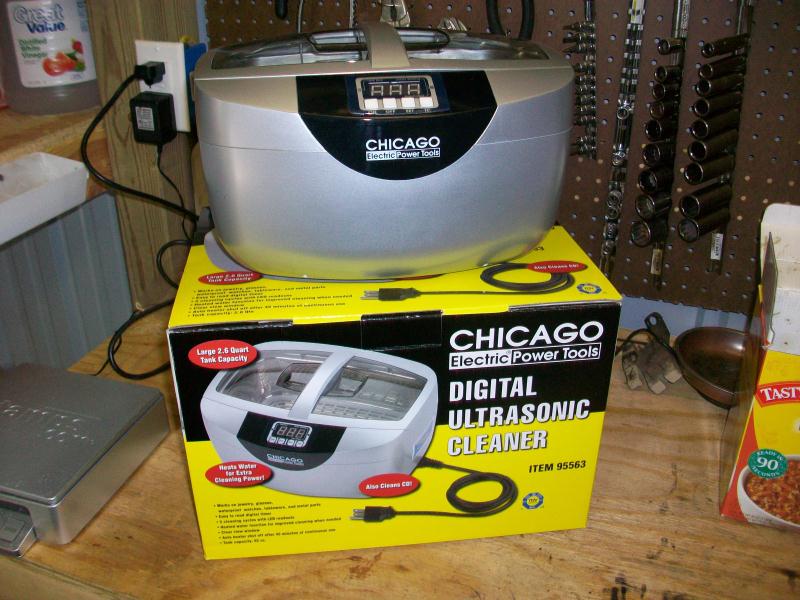
I use a bottle of "Awesome" cleaner purchased at the local dollar store. Basically, I empty the whole bottle into the tank, and then fill up the rest to the Max line with lukewarm water. Maybe your wife uses this cleaner... here is a photo of it:

You turn the heat function on, wait several minutes for the unit to make the water hot (about 125 degrees or so), and then simply place your hardware in the tank. There is a hard plastic screen/tray at the bottom to keep materials off the bottom of the tank of itself (something about a transducer). I actually fashioned a handle for either side so that retrieval would be much easier. That solution gets FILTHY!
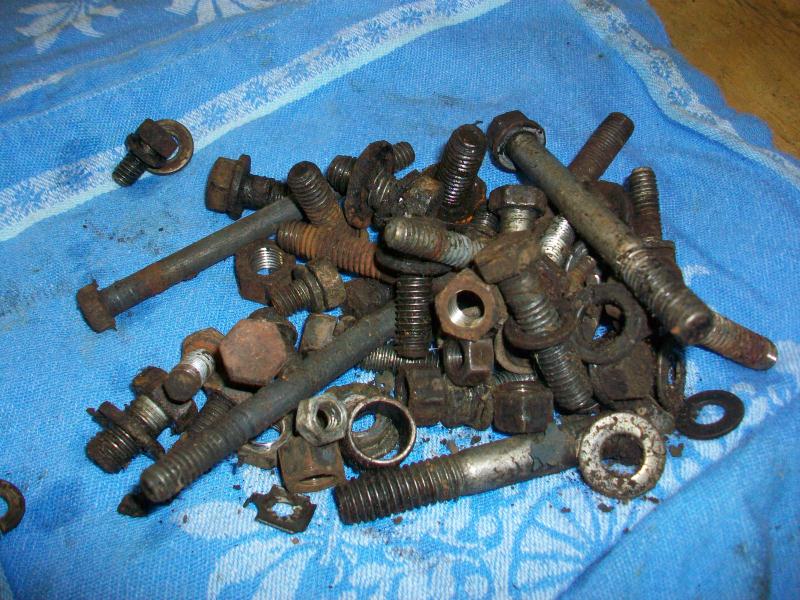
The photo above is representative of what I dump into the tank, only this is HALF THE PILE. I do not pre-wash or anything, just put them in as you see them, grime and all. (I would probably not have to do 2 time cycles if I only used a pile this size)
They come out like the photo below and I let them dry out for an hour or two.
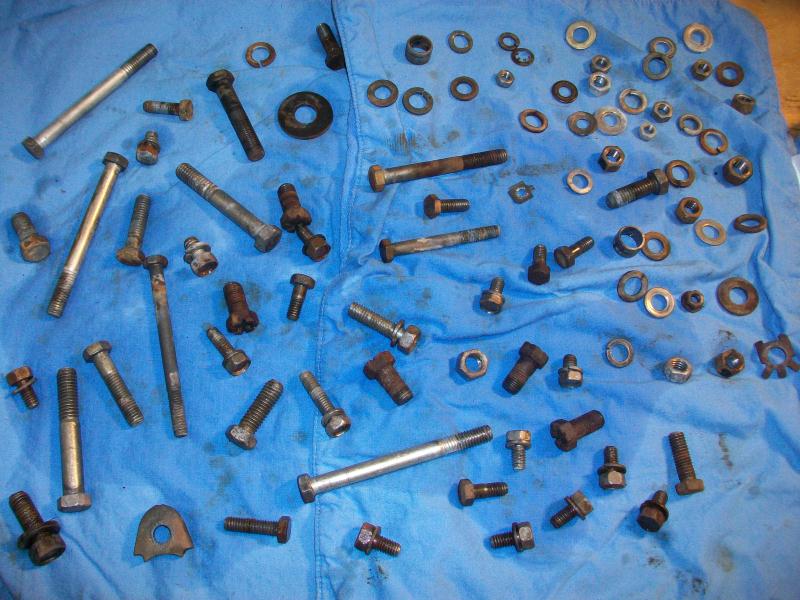
Maybe the only thing that I have to do is simply rinse them in a washt tub with water for a few seconds... the ultrasonic cleaner basically loosends and lifts all the grime off th threads. All that's left is clean metal and rust of course...
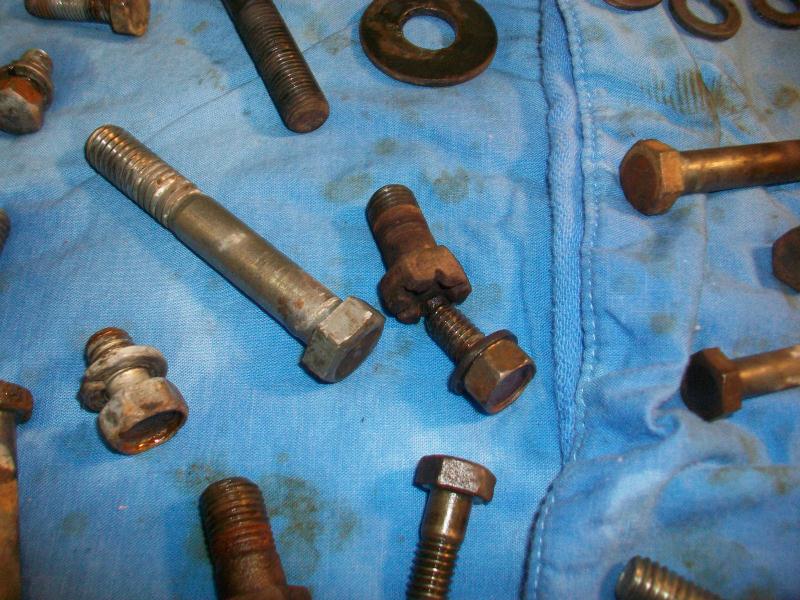
You can see a couple of Y block oil pan bolts (you know, the ones that have that recess on the head where grime likes to collect?)... the ultrasonic cleaner also lifts the gunk off of those. The washers work best when strung on a bailing wire and suspended in the tank...
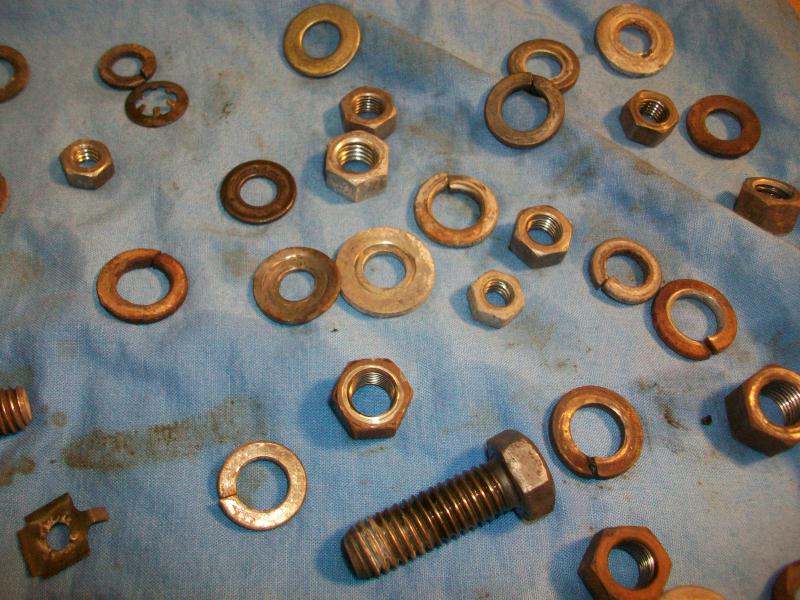
I was stoked on the Ultrasonic Cleaner and the results, but the best is yet to come... next post!
|
|
By Daniel Jessup - 13 Years Ago
|
While the hardware cleans up nice using that ultrasonic cleaner (man, it was work just going one by one in my parts cleaner tank!), I still had the ideas about a vibratory tumbler, etc. I had a thought that if I could find a better way to use my bead blast cabinet, that would be the most efficient and cheapest way I could get the job done on all of this vintage hardware. I really was not a fan of the mesh buckets like TP tools carries, so I kept racking my brain from something that could hold the hardware, but let the media sift through. Check this out... it's a cricket tube! 
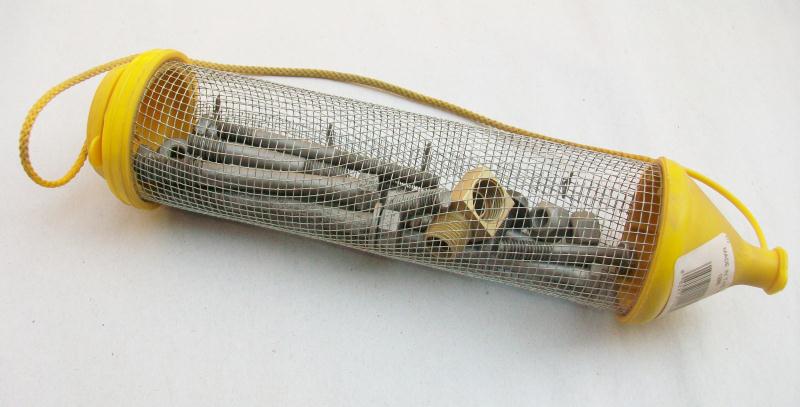
I took a load of bolts, nuts, hardware like this...

popped the cap on the mesh cricket tube and blasted away for a couple of minutes. Why I like the tube over the buckets and colanders I have seen/used is that nothing can fall out of the tube no matter how you turn it, you can "roll" the tube in your hand to get every part in there, and you can turn it at any angle. It is very QUICK!

No muss, no fuss. The irony here? That cricket tube is made in the USA, but I bought it at Wal-mart this morning!!! 
|
|
By MoonShadow - 13 Years Ago
|
I keep hoping to find out what I need to buy to add transducers to my existing parts washer. I can't help but think transducers could be added to an existing metal parts cleaner to add sonic on top of the solvent. The available solvent today really sucks! I've never found one that would hold a candle to the old, EPA bad, stuff. I loved the ZEP cleaner but you had to be careful with aluminum parts as it would eat them if left in too long. Has anyone found an available parts cleaner solvent that really works?
The next thing I'm thinking about is adding an over the side heat element to heat up the solvent. Any thoughts? Chuck
|
|
By Daniel Jessup - 13 Years Ago
|
|
Chuck you are right on. With weaker solvents (or just a cleaner that is not caustic), you gotta have so much mechanical action to clean parts that "Harry Homeowner" is left with few options. The big stuff is always fun, but I've got the hardware figured out anyway. how do you handle rust?
|
|
By MoonShadow - 13 Years Ago
|
I blast the he:: out of it! I have a decent sized blast cabinet and a pressure blaster for the big stuff. By the way I mentioned the Cricket device to my wife. Asked her to pick me one up next trip to Wally World. Thanks for that tip.
Hopefully someone on the forum will know what it will take to do the sonic adaption. I see the transducers for sale at varying prices but I know nothing about them as far as size etc. Chuck
|
|
By lyonroad - 13 Years Ago
|
|
Daniel, have you ever tried CLR. When I did my my first vehicle I came across it and found that with a 50/50 solution of CLR and water a lot of rust would be removed with just an over night soaking. Unfortunately I have a sinking suspicion that the current makeup of CLR has been changed (for environmental reasons) and is now weaker. I also found that certain wood sun deck cleaning products will remove rust. You have to experiment because some make it worse.
|
|
By MoonShadow - 13 Years Ago
|
|
There are chemical coating to neutralize rust like Navel Jelly and Eastwoods products. They work by applying them directly to rusty surfaces usually prior to any serious cleanup. I guess they need the rust particles to activate? I've used it on my 28 frame and it seems pretty permanent. You can put body filler, primer and/or paint on top of it. Chuck
|
|
By Daniel Jessup - 13 Years Ago
|
Seems I remember this idea about soaking rusted parts in molasses and water mix? I wonder how that would do in the ultrasonic cleaner with some heat applied... anyone out there ever try that one?
Also, the other day I was surfing the internet and found a couple of videos where guys were putting seriously rusted parts in a tub, wiring one end of a battery charger to the part(s) and the other end to piece of rebar or something similar to act as one of the poles. I believe they were using some type of a borax?
|
|
By MoonShadow - 13 Years Ago
|
|
Do a search for Caustic soda. The formulas and instructions are online. You can buy the powder at your local hardware store. This stuff has to be mixed in a plastic tub. Definately attacks metal. But the fall out is that it is an acid. That mean elbow length rubber gloves and eye protection. A rubber apron wouldn't hurt. I don't want to scare you off but when you have a bunch of small parts to do it mayrbe worth making some up. As far as disposal thats up to you, I don't know the EPA requirements for it. I've seen the reverse chrome setup with the electrodes and it seems to work. I don't know anyone who has tried it. Chuck
|
|
By lyonroad - 13 Years Ago
|
|
You can also soak small parts in vinegar but it is slower than CLR in IMO. You then have to brush the parts if you use vinigar whereas CLR disolves the rust and gives the part a phosphate like surface. I also saw the video on the electrolysis process. It looks hard core.
|
|
By GREENBIRD56 - 13 Years Ago
|
I use the "purple stuff" grease killer to emulsify the oil on parts and it works pretty well - I think it came from Wally World too. They have a big jug with about three gallons in it. A good spray soak with it in an old plastic bucket is a quick "first shot" before beginning any of the other treatments.
After all of the magic tricks are done - here's a tip from a restoration guy I met .....next use "Birchwood Casey" Perma Blue - Liquid Gun Blue to put a controlled corrosion coating on the surface of the hardware. It is found next to the gun cleaning supplies at many sporting goods stores - little blue three Oz bottles are common. The active ingredient of the stuff is "Selenium Dioxide" - follow the directions please. It will turn your cleaned (washed, neutral rinsed, and dried) hardware a nice shade of Black. I put a bunch of dry small parts in a zip lock with just enough of the stuff to wet every surface. Shake it out onto an old newspaper to dry. You can paint over the finished surface - or oil it with motor oil.
|
|
By The Master Cylinder - 13 Years Ago
|
|
MoonShadow (3/24/2013)
Do a search for Caustic soda. The formulas and instructions are online. You can buy the powder at your local hardware store. This stuff has to be mixed in a plastic tub. Definately attacks metal. But the fall out is that it is an acid. That mean elbow length rubber gloves and eye protection. A rubber apron wouldn't hurt. I don't want to scare you off but when you have a bunch of small parts to do it mayrbe worth making some up. As far as disposal thats up to you, I don't know the EPA requirements for it. I've seen the reverse chrome setup with the electrodes and it seems to work. I don't know anyone who has tried it. Chuck
Actually Caustic Soda (sodium hydroxide) is an Alkali with a high pH, opposite an acid. Think Lye. But regardless, heed Moonshadow's warning and use proper safety protection. May want to refer to the MSDS for more info.
There was a discussion on The Ford Barn about rust removal using Molasses. Haven't tried it personally but quite a few said it works great and is environmentally safe...  
I have used Evapo-Rust with good results. Evapo-Rust
|
|
By stuey - 13 Years Ago
|
fascinating thread
years ago i looked at ultrasonic cleaners. most were very small and used in the jewelery trade. bigger versions were just too expensive.
small ones used peiziolectric transducers and larger ones used magnetostrictive transducers (buzzy transformers) these may be added to existing tanks but you may have to have some sort of frequency control all beyond my capabilities. years ago there was an article in HR magazine with a carb using peiziolectric technology.
re caustic soda (oven cleaner) be careful how you mix it. now i am not sure which way is correct so do some research but i think you must add it to a bucket of water if you add water to the caustic it can get pretty violent.
for not too serious rusty parts i use phosphoric acid , its in Coca cola, sometimes sold as Metal Prep.
re molasses sounds real good but i have not been able to track it down over here. is it called "strap molasses"if so is it different to any other kind??
stuey
UK
|
|
By The Master Cylinder - 13 Years Ago
|
|
Be extremely careful when mixing caustic soda. Mix it too fast will cause a violent, exothermic reaction.
|
|
By pegleg - 13 Years Ago
|
|
Chuck, be REAL careful with the heat idea. You have no idea how much you're speeding up the reaction, and it could be too much. Master's correct about the not an acid part. A caustic is actually the opposite of an acid. Still burns you though. Remember your high school chemistry?
|
|
By MoonShadow - 13 Years Ago
|
|
I'm pretty sure that I slept through Chemistry. Don't remember though. I was talking about heat with the solvent in the parts washer not with anything else. I know there are ultrasonic tanks out there big enough for car parts like in Jay Leno's garage (car palace). But they are very expensive. I am certainly no rocket scientest so that is why I've been looking for someone that can work out the details for adding ultrasonic to an existing tank. I would think if it could be done reasonably an adapter kit could be marketed to the home garage folks. Maybe even the regular garages. Chuck
|
|
By The Master Cylinder - 13 Years Ago
|
|
pegleg (3/25/2013)
Chuck, be REAL careful with the heat idea. You have no idea how much you're speeding up the reaction, and it could be too much.
You reminded me of high school auto shop and the heavy duty "Parts Cleaner". Don't know what the solvent was in it but it was heated and got parts REAL clean. Thinking back they would never allow a bunch of teenagers these days anywhere near it.
Anyway, one of the guys put an aluminum head (Fiat I think) in it and left it in over the weekend.  Destroyed the head. With all the craters eaten out of it there was know way you could mill the head enough to get it flat. Even all the valve seats fell out. Shop teacher was PO'd. Destroyed the head. With all the craters eaten out of it there was know way you could mill the head enough to get it flat. Even all the valve seats fell out. Shop teacher was PO'd.
|
|
By MoonShadow - 13 Years Ago
|
|
We did that with a VW engine case and a 50 gallon drum of ZEP (RIP EPA). We had it soaking during the afternoon but forgot to take it out before leaving. The next morning it had holes through the thin parts of the case. GREAT parts cleaner but real nasty stuff for the ecology. Chuck
|
|
By Pete 55Tbird - 13 Years Ago
|
Rust removal can be SAFE and CHEAP and CLEAN. Do a youtube search of rust removal using electrolysis and watch a few videos. Just remember do not use stainless steel for the sacrificial anode as that will produce TOXIC FUMES.
This flat out works and gets behind panels and inside blocks and otherwise inaccessible parts. Check it out. Pete
|
|
By wlj1943 - 13 Years Ago
|
Mark,I noted the same thing about CLR.
I have used the vibratory for years for small parts; key is the right media and everything dry and no grease or oil beforehand.
I prefer to de-rust electrolytically, especially for valuable or machined parts, but it can be kind of slow, needs monitoring and takes a good filtered DC power supply. Also you must do it outside as the process emits hydrogen, but it removes only "rust". Lots of references to this on the internet; I first used a article about this in the Model T club magazine circa 1990.
WLJ
|
|
By wlj1943 - 13 Years Ago
|
Stuey,It's Black Strap molassas. Yes it works but it is slow.
WLJ
|
|
By MoonShadow - 13 Years Ago
|
|
I can't imagine how much it would cost to fill even a small vat with Molasses. Probably be cheaper to send the whole batch out for cleaning. Chuck
|
|
By stuey - 13 Years Ago
|
thanks WLJ
i'm led to believe horse owners use it.
another word of caution re caustic it eats cam bearings as i found out 
stuey
|
|
By Ted - 13 Years Ago
|
|
If considering doing the molasses bit, do it only on rough blocks or castings and not fully machined ones. If done to a fully machined block, it can destroy the fresh cross-hatching or hone job on the cylinder walls. Yes, I get to see it all here.
|
|
By MoonShadow - 13 Years Ago
|
|
Ok Ted, so what do you use to clean parts? I'd give my left n&t for a 25 gallon barrell of the old ZEP. Chuck
|
|
By Daniel Jessup - 13 Years Ago
|
For rust removal, some of you guys may have quite the experience and expertise with electrolysis, but I have never tried it before. Usually I take the mechanical action for rust removal (sand blasting or bead blasting in a cabinet) or the occasional "rust converter" chemical. So... this afternoon I filled a tub with several gallons of water, stole some of mama's Arm and Hammer Washing Soda and put in several tablespoons, immersed a crispy intake manifold, put a positive lead on a scrap piece of sheet metal, the negative lead went to the intake manifold, and I plugged in the battery charger on a 2 amp setting. (after I made sure that the two objects/two poles were not touching  ) )
Immediately I saw bubbles and after 3 minutes you could literally see rust moving across the bucket...  NICE! Don't know how long this is going to take, but I do know that this intake had a couple of runners with some rust in them. There is quite a bit of rust on the exterior. I will post photos sometime soon when I get my camera unloaded. For those of you that do this kind of thing with an intake manifold when it has so much on the interior, what kind of results can I expect here? NICE! Don't know how long this is going to take, but I do know that this intake had a couple of runners with some rust in them. There is quite a bit of rust on the exterior. I will post photos sometime soon when I get my camera unloaded. For those of you that do this kind of thing with an intake manifold when it has so much on the interior, what kind of results can I expect here?
|
|
By Daniel Jessup - 13 Years Ago
|
Here are a couple of photos...
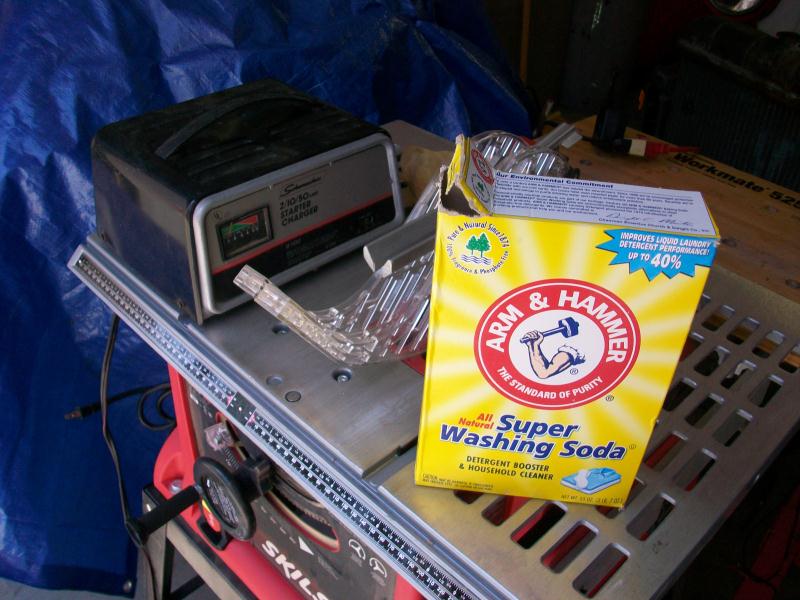
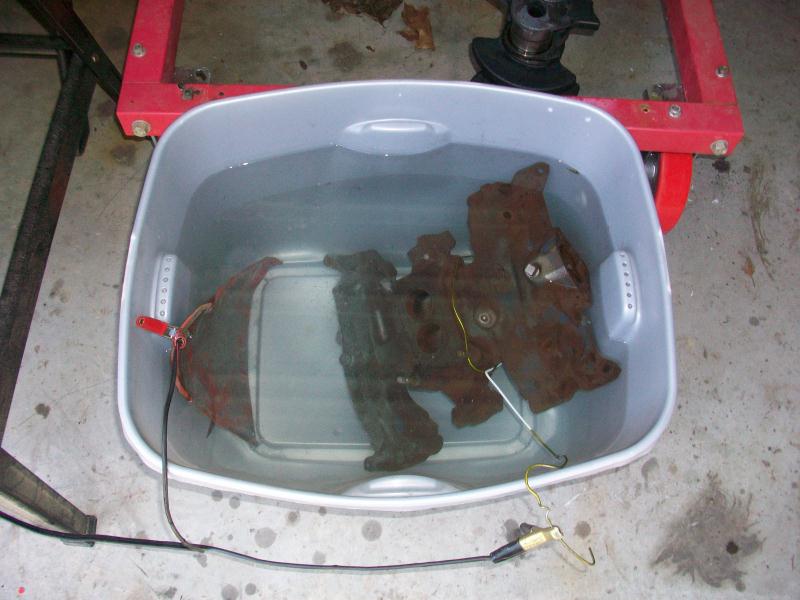
|
|
By The Master Cylinder - 13 Years Ago
|
|
Probably goes without saying but just be aware that 200 mili amps (.2 amp) can kill you.
|
|
By bird55 - 13 Years Ago
|
You will also find out you will have a pretty nasty stew left over. Find some gravel parking lot to pour it in. and don't expect to ever grow anything there.
I had mixed results when I tried this. I still ended up having to blast everything. It's still my preferred method. It provides the best (I think) surface for repainting and finishing. my 2 cents.
|
|
By Pete 55Tbird - 13 Years Ago
|
I will have to disagree that you have to be careful about dumping the old water/rust/ baking soda. I just pour it out on my lawn. Iron, water NO CHEMICALS WHATSOEVER.
As far as results. To clean inside passages that you can not see into, this works. It is used to clean old iron cannons that have been under the ocean ( salt water) for hundreds of years.
If the electricity scares you get a trickle charger with a GFI or steal your wife's hair dryer that has one on it. Pete
|
|
By The Master Cylinder - 13 Years Ago
|
|
Pete 55Tbird (3/30/2013)
If the electricity scares you get a trickle charger with a GFI or steal your wife's hair dryer that has one on it. Pete
Since the output of a battery charger, 12v DC, has no physical contact with the input, 120v AC because it goes through a transformer and rectifier I seriously doubt that a GFI would help unless the battery charger itself fell into the water while you had your hands in it. 
As for being scared of electricity, let's just say I have respect it and use caution around anything that may harm myself or others.
|
|
By Pete 55Tbird - 13 Years Ago
|
DC VOLTAGE. I wonder about how high a voltage DC could be dangerous so I did a Google search. Most answered that in theory 1 AMP might under the exactly right condition kill you it was highly unlikely.
Here is a link to the CDC ,center for disease controll, run by the US Govt. http://www.cdc.gov/niosh/hhe/reports/pdfs/1992-0064-2222.pdf
http://www.cdc.gov/niosh/docs/98-131/overview.html
It lists around 16 mA as a current level where you may not be able to let go.
Around 20 mA can paralyze your respiratory muscles and stop breathing.
100 mA can cause ventricular fibrillation and stop the heart. This is particularly dangerous because even if you get disconnected from the current, your heart won't necessarily restart.
Just thought I would throw that out there. Pete
|
|
By Daniel Jessup - 13 Years Ago
|
Thanks for the warnings fellas. I do try to be careful with any tool in the shop, but especially electricity!
Here is how the intake came out of the vat after 2 and a half days...
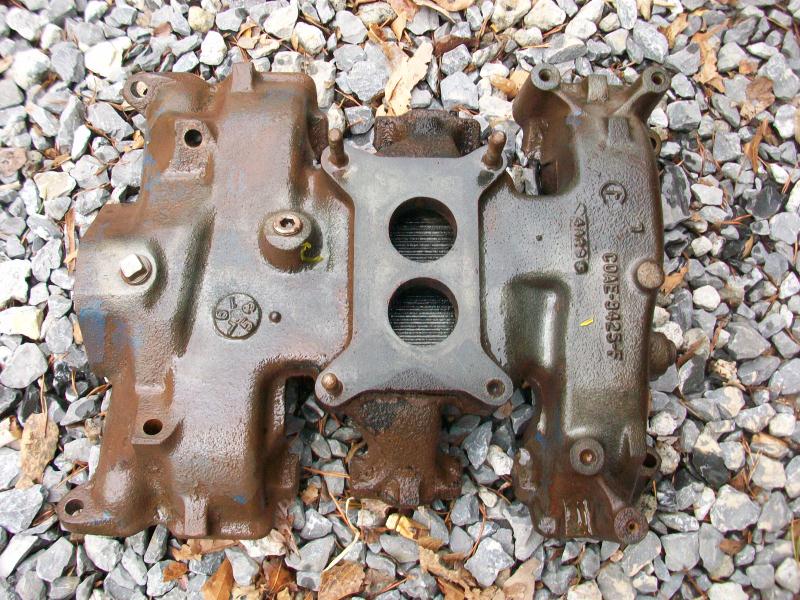
Most of the articles I read said something about taking a wire brush to it because all of the rust left on the iron piece would be silt like and come off pretty easily. I can vouce for that. Anything brown on there just wiped off or maybe peeled off in the places. A wire brush with little effort did the trick. It did loosen up all the stuff inside the runners too.
Here is what it looked like after 5 minutes...
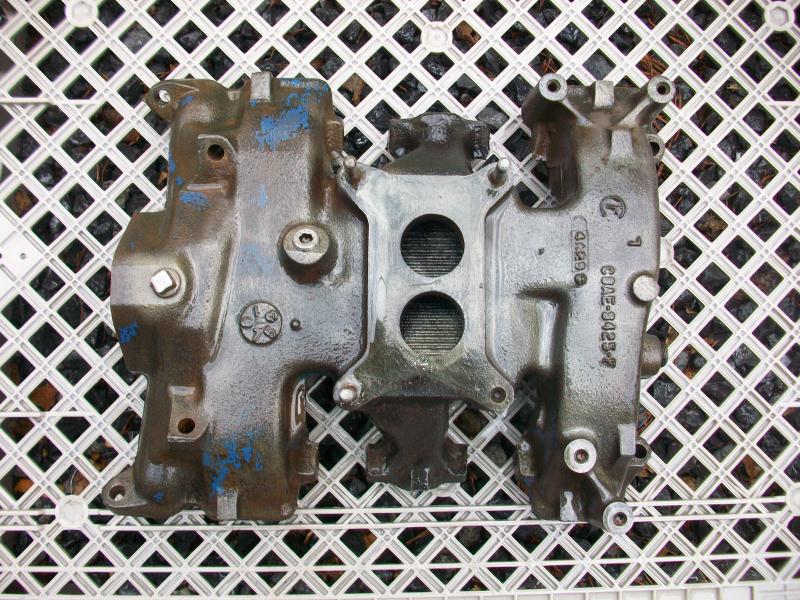
And this is what it looked like after I put it in Duplicolor engine primer gray...
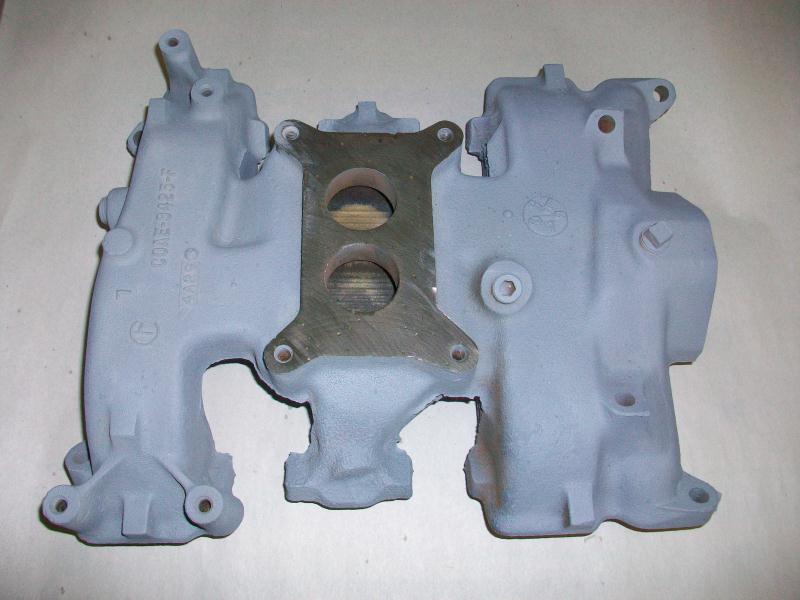
I was impressed by what it did to the inside more so than the outside, but it certainly did its work on this manifold. I guess for the "crispy" parts you have this might be a good way to go if you are willing to wait. Of course, this thing was in the vat for a long time, but I wonder how much shorter it would have been to just turn it up to the 10 amp instead of 2 amp setting? I went ahead and threw in 2 headlight buckets in the vat after I cleaned it out and set it up again. Should have done before and after of those too.
I will make another post about the ultrasonic cleaner though. This afternoon, that thing did a great number on a 2 barrel ECG carburetor with just that $ store Awesome cleaner bottle and water. Unbelievable. Wonderful results. What it did not get off after I pulled it out of the tank, the gunk just wiped right off.
|
|
By brokengate - 13 Years Ago
|
|
Daniel you're doing a great job and it sounds like you're having a good time doing it, how bout I send you some of my parts to have fun with, Sincerely Tom Sawyer.
|
|
By Daniel Jessup - 13 Years Ago
|
Here are the results of the carb parts in the ultrasonic...
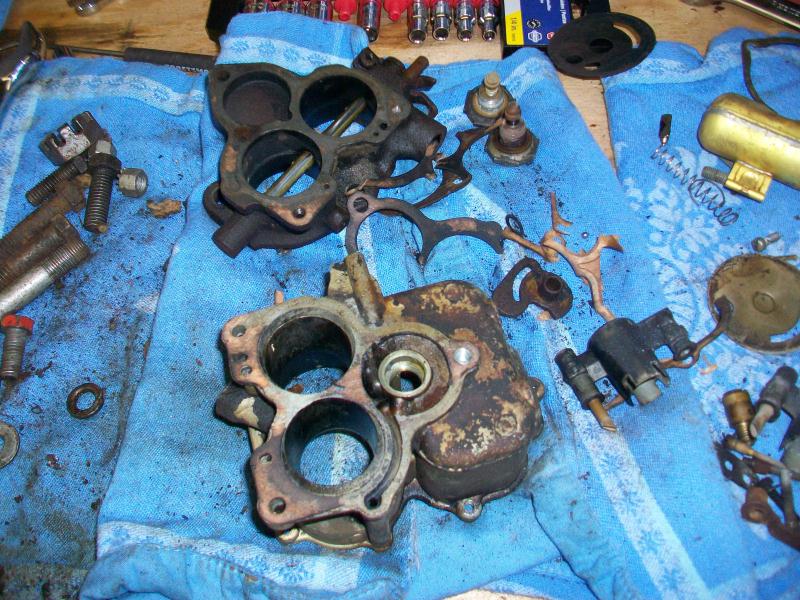

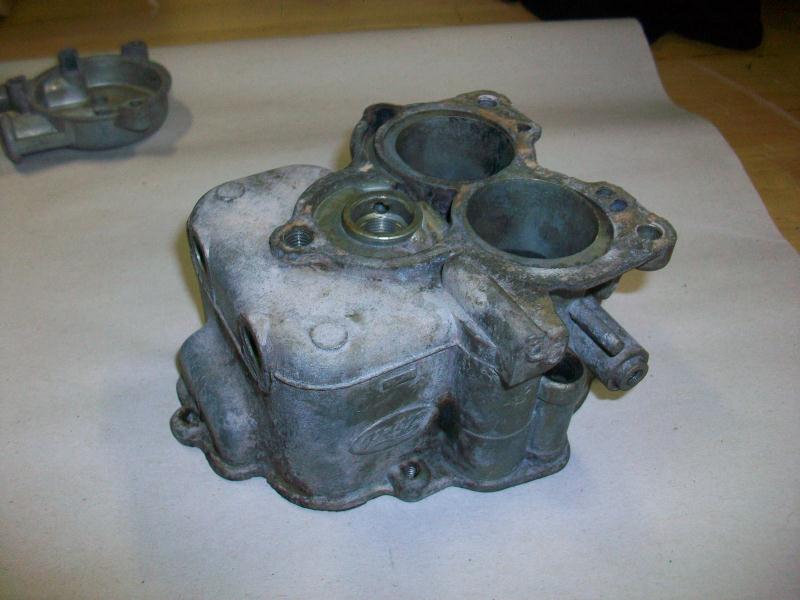
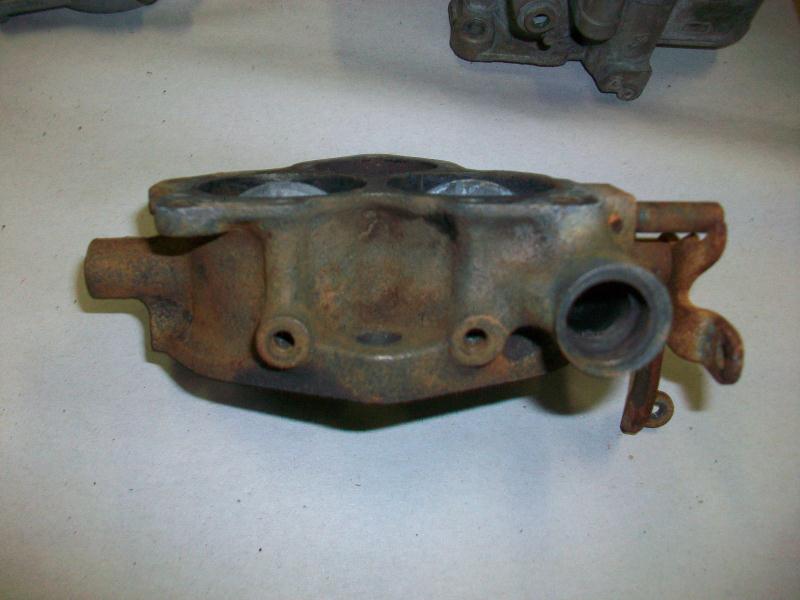
I used just one bottle of Awesome to do the fuel bowl, choke housing, and the butterfly base. The parts did not come out PERFECT, but you can see how great they look. This is with no pre-soak, no scrubbing, etc. Just place them in the tank and rinse when the cycle is complete.
|
|
By Daniel Jessup - 13 Years Ago
|
|
brokengate (4/2/2013)
Daniel you're doing a great job and it sounds like you're having a good time doing it, how bout I send you some of my parts to have fun with, Sincerely Tom Sawyer.
LOL - bring it on! Of course, what you are gonna have to pay in shipping is gonna put you over the top. Reminds me of the days we used to whitewash the fence, Sincerely Huckleberry Finn.
|
|
By MoonShadow - 13 Years Ago
|
I wish when you guys use these weird references you would refer to the original works? Sam C.
What type of ultrasonic did you use? Chuck
|
|
By Daniel Jessup - 13 Years Ago
|
Chuck,
All I did was put in a bottle of the $ store Awesome cleaner (about 1 liter or so), and then the rest was simply water. The unit has a heater on it (about 125 degrees max), and there are several different pre-timed cycles you could use. I used the 8 minute cycle on the carb parts. The unit is a Harbor Freight (Chicago Electric, spelled China Electric) model that holds a little over 2 liters of solution. I think I put a photo of the unit up in the first post I made in this thread. Worked very well as you can see.
|
|
By MoonShadow - 13 Years Ago
|
And you thought I could remember that? I've looked at the Harbor Freight cleaners and was curious about how well they worked. I wish something larger or converting an existing parts cleaner was priced within reason. Did you see the video of Leno's machine that will take a complete block? Super neat! Chuck
http://www.youtube.com/watch?v=p36RPkxa_I4
|
|
By Daniel Jessup - 13 Years Ago
|
Thanks for the link, I will have to take a look at that video. Historically I have always liked to use the heavy duty carb cleaner in the gallon can where you just submerge your parts for several hours. Now though, I have not really found anything that compares to what I used... even back in the early 90's  . With this ultrasonic cleaner, now I can get the parts pretty clean without caustic solution, and with the cleaner so cheap it is almsot a no-brainer to use. With this ECG carb I was surprised to see #52 jets... IIRC these things always ran a number higher I believe. I had to booger one up to get it out. . With this ultrasonic cleaner, now I can get the parts pretty clean without caustic solution, and with the cleaner so cheap it is almsot a no-brainer to use. With this ECG carb I was surprised to see #52 jets... IIRC these things always ran a number higher I believe. I had to booger one up to get it out.
By the way, there was some evaporated gasoline goo on the original float needle.... and guess what took care of that? The ultrasonic!
|
|
By Daniel Jessup - 13 Years Ago
|
Ok, my latest foray into electrolysis went like this...
1. Clean out the old tub
2. Refill with water and 10 tablespoons of the Washing Soda
3. Clean off my sacrificial metal of rust deposits, etc.
4. Find a pair of headlight housings (usually they are pretty rusty). This pair from a 55 were rusty on the inside, but especially on the outside.
5. Immerse the housings and the sacrificial sheet metal in the solution
6. Attach the alligator clips and plug it in.
7. Turn the battery charger UP from 2 amps to 10 amps
8. Wait THREE days!
Here is what they came out like...
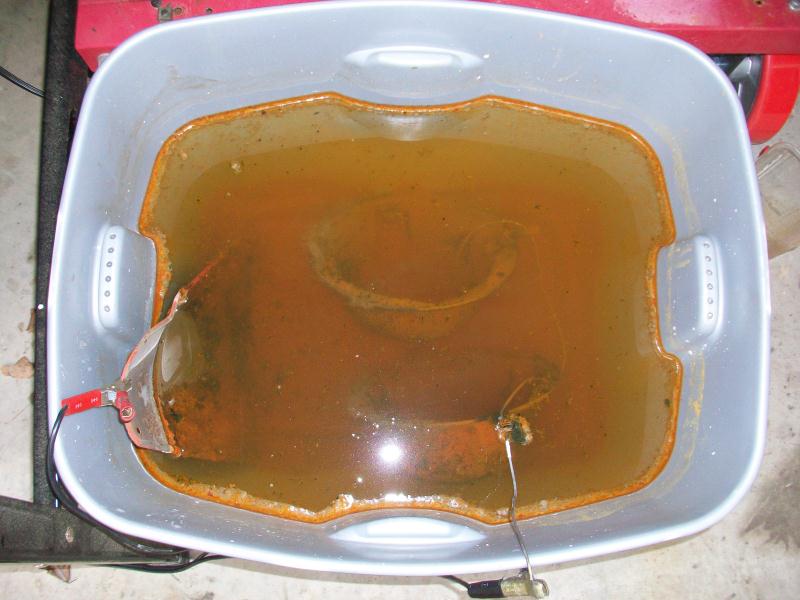
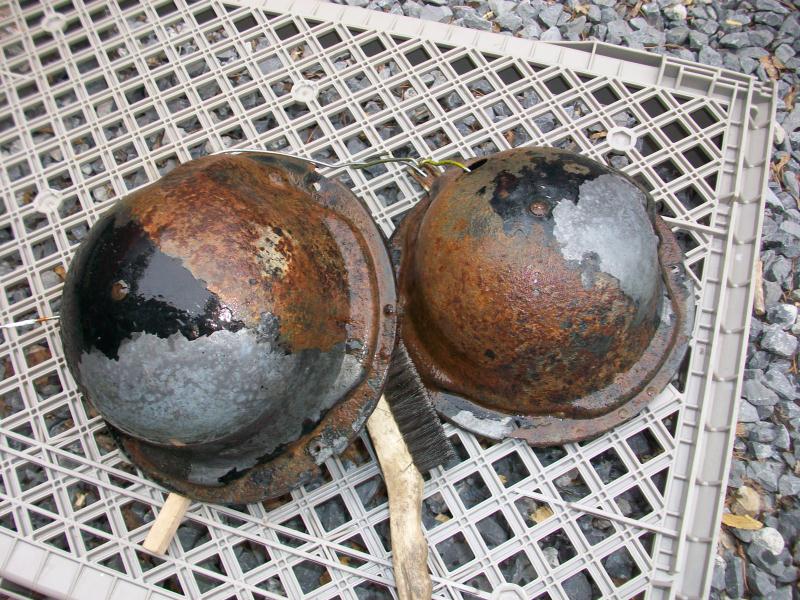
After about 5 minutes of brushing both of the housings, inside and outside, this is what I got...
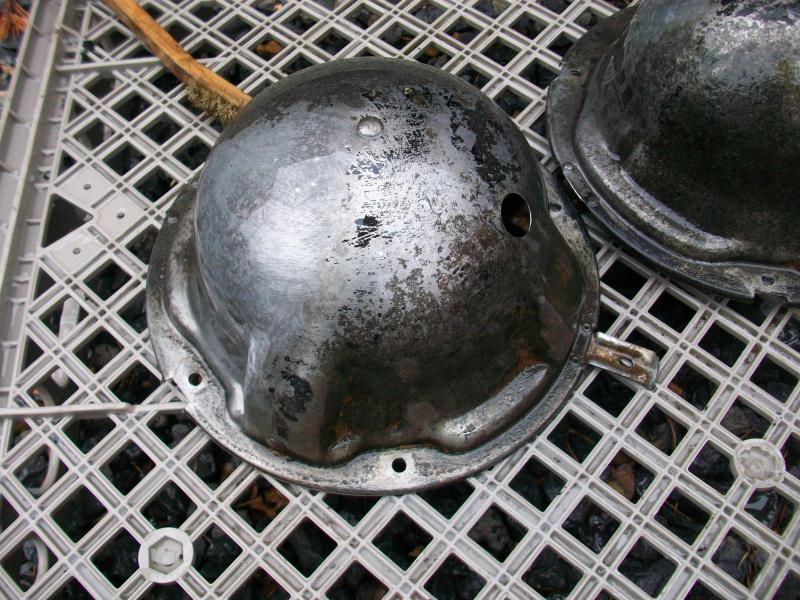 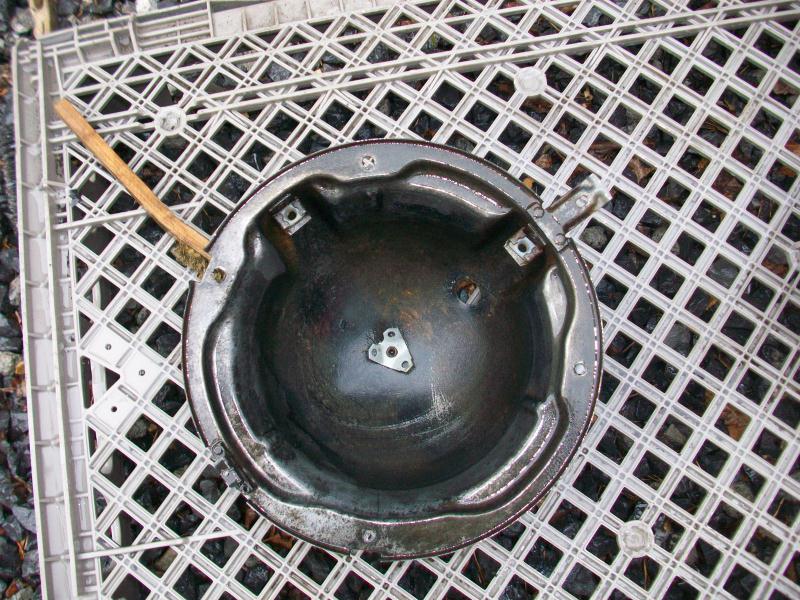
I was more impressed by what happened on the outside of the housings than the inside. A few notes...
1. This was 3 days of sitting in the tub... I am beginning to wonder if it would not be worthwhile to take the part out after a day, brush it all off, put in new water and soda, and then let it go another day... would my results be better or does it even matter?
2. This time the sheet metal I was sacrificing was about as twice as much rusted up and corroded as the first round with the intake... I am figuring that it was because I had the charger set to 10 amps this time.
3. These parts did not clean up quite as nice as the intake manifold. Don't know why that is. Maybe more surface area to remove rust because I had two of them in there at one time?
4. I am beginning to wonder how the tub might do with small hardware, although I like my method of blasting small parts much much better.
5. Would there ever be a reason to use a different cleaner or soda in the cleaning solution other than the Arm and Hammer Washing Soda that I have been using?
6. Is there a better way to remove the residual rust on the parts other than a handheld wire brush?
LOL - anybody think I am crazy here with all this experimental cleaning and derusting? 
|
|
By lyonroad - 13 Years Ago
|
|
I don't think you're crazy - keep experimenting, but stay safe.
|
|
By The Master Cylinder - 13 Years Ago
|
Daniel, Saw something of interest on The Ford Barn the other day. It was suggested to use electrolysis similar to what you are doing to clean rust out of gas tanks. Filled tank with the solution, using a piece of exhaust pipe for the Sacrificial metal inserted through the sending unit hole and insulated from touching the tank and put the power to it. Supposed to clean all the rust out of the inside of the tank. Don't know if they sealed it after or not.
Thought it was interesting and pass it along to others with a rusty tank.
Picture from The Ford Barn;
http://www.fordbarn.com/forum/attachment.php?attachmentid=127687&d=1367192717
|